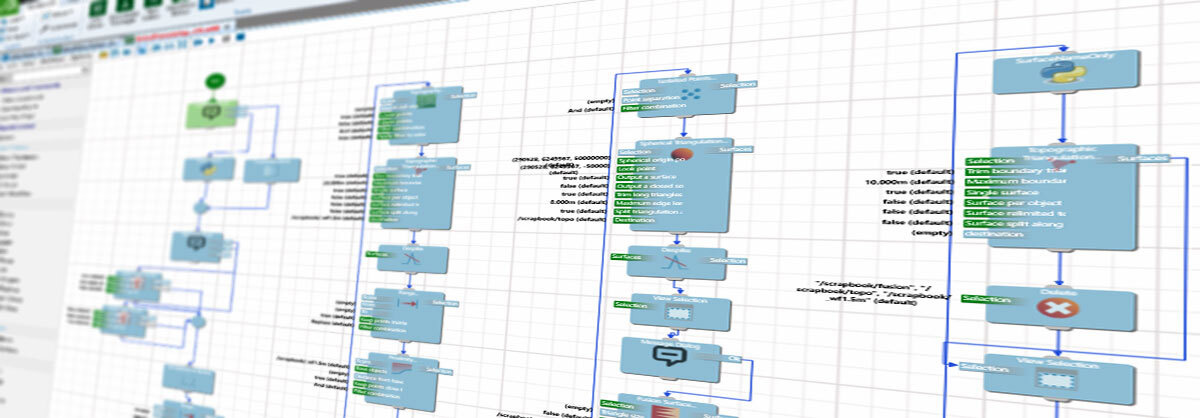June 2020 Issue Index
Core technology futures
The software and systems which underpin the Maptek product suite enable efficient interoperability between high-performance software solutions.
Product Manager – Core Technology, Jeremy Butler leads the Maptek Core Technology team. On the back of the formal launch of application extension toolkit Maptek Extend, one of the projects he has been driving, Butler shares his vision and expectations for Maptek Core Technology.
What informs your strategy?
Our vision and strategy provides necessary frameworks, integrations and shared technology components for Maptek products to interoperate, look, act and feel similar while preparing for transition to adopt new technologies and paradigms.
We’re identifying and taking action to expand our horizons and extend what customers can achieve with Maptek technology, beyond end-user products.
What trends are you seeing?
Customers everywhere are trying to solve novel problems themselves. Different approaches include citizen-developers (writing scripts, internal applications, designing workflows or standardising processes), integrating disparate solutions, engaging with consultants and third-party providers as well as internally employing data scientists and developers.
I focus on how Maptek can provide solutions and technology for those customers who are pursuing greater optimisation and automation objectives.
Where a Maptek product group tackles specific problems, the Core Technology team aims to help by design of distributed data models and systems, cloud computing frameworks, integrations, workflow orchestration technology, APIs/SDKs and pathways for our solutions to assist with customers’ digital transformation agendas.
It may sound like we’re setting our customers up to compete with us in software development, but these avenues allow us to help drive customer success in alternative ways that also support integration and solve niche problems that require higher levels of agility or aren’t well suited to productisation.
What are you focusing on?
Automation: High on everyone’s agenda, whether for machinery, decision making, software or data.
Citizen-developers and low-code development: Enabling technologies and simplified integration pathways can give everyday users far greater control over automation pipelines and empowerment in delivering operational efficiencies.
Transparent, performant and distributed data technology: Many organisations would like digital twins that cover every imaginable scenario. While no single solution caters for this, it’s more achievable with several integratable solutions configured to suit a set of needs. To adequately solve mining industry problems and edge computing requirements – until high-speed internet becomes universal across the globe – some solutions will need to work in a distributed environment to cater for hybrid cloud/site scenarios and be fault tolerant against internet and network connectivity variability.
Distributed computing: We no longer have to rely on our main desktop or laptop to do all the processing work or even require a high performing machine to get as much done. Instead, using distributed computing technologies and supporting infrastructure allows us to spread work across many real or virtual machines. We can also test hypotheses, get more done in the same time frame and string together operations in an automated way.
Maptek already has products that embrace these spaces and will continue to exploit them. An industry wide appetite for artificial intelligence and machine learning applications is also being explored through Maptek DomainMCF and our strategic partnership with PETRA.
How do you keep up?
It can be challenging at times. I read a lot, keep up with industry groups, get involved with RFQs and RFIs, monitor hundreds of support cases and talk with people. I am also a user of our products, allowing me to keep track of how they’re going and maintain a level of expertise.
How do you balance customer requests with blue sky thinking?
Core Technology differs from other Maptek product/solution groups. We aim to deliver enabling technology rather than a final end-user solution to a specific problem. The flow of customer requests can be direct and indirect depending on the software context.
There’s a delicate balance between maintaining existing products, providing technological pathways forward for them and enabling entirely new products to emerge.
How much creative space do the development teams have?
Maptek has plenty of experience with developments that start with a degree of uncertainty and require creativity and discovery. This is my preferred pathway as it allows an idea to grow into fulfilling a need more naturally. What you need may end up different to what you think you need.
What is Maptek Extend?
Maptek Extend increases the utility and automation of existing Maptek software by facilitating custom scripting, letting you add value to Maptek applications.
- Application extension toolkits allow users to expand the capabilities of Maptek software
- Shared technology components exponentially increase the value of standardising on Maptek solutions
- Cloud computing and distributed data models and systems are the way of the future
Maptek Extend
Maptek Extend establishes the groundwork for access to a more robust and comprehensive application extension toolkit. This enables customers to expand the capabilities of Maptek software.

